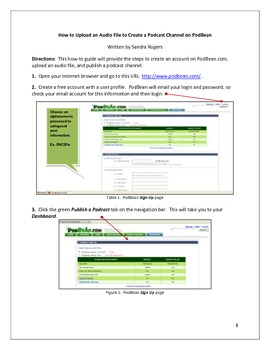Technology Guide for Uploading Media to Create a Podcast Channel (CCSS aligned)
Teacherrogers
111 Followers
Grade Levels
2nd - 12th
Resource Type
Standards
CCSSRL.2.5
CCSSRL.3.5
CCSSRL.4.5
CCSSRL.5.5
CCSSRL.6.5
Formats Included
- PDF
- Internet Activities
Pages
6 pages
Teacherrogers
111 Followers
Compatible with Digital Devices
The Teacher-Author has indicated that this resource can be used for device-based learning.
Description
This guide shows students how to upload a media file to a podcast channel, specifically Podbean.com. It includes a 25-word glossary of technical terms used in the task. It can be used to supplement any course content as a project. For instance, a student can produce an audio file on any topic and then publish it to a podcast channel as part of an oral language project. Poetry readings, musical performances, or reporting the weather are just a few ways to incorporate podcasting.
Using emergent technologies is an important skill for the 21st century learner to apply, not only in class, but also in their personal learning networks, college, and future career. Moreover, this product can be used in K-12 schools to address the media skills embedded in the Common Core Standards (2010) for career and college readiness benchmarks. For instance, the English Language Arts Standard for speaking and listening in Grade 2 states (2.5 Presentation of Knowledge): “create audio recordings of stories or poems.” Podcasting would be an excellent vehicle for this task. A similar standard for presenting content in multimedia is included in grades 3-12 core standards.
Goal Statement: Students will successfully upload a media file to Podbean.com for an oral language project by following the steps in the screencast and supporting how-to guide. The learning context is during class time in the computer lab or on a home computer. Students will need to have already learned how to create an audio or video file and save it as a MP3/MP4 format on a flash drive for school work.
Access the demonstration video for free on Teacherrogers YouTube Channel to evaluate the quality of my work:
Screencast to Upload a Podcast to Podbean
Note: This product is part of a larger technology project that last several weeks. See complete project here. Podcast Project
Thank you for shopping Teacherrogers store!
Sandra Rogers,
Instructional Designer
Using emergent technologies is an important skill for the 21st century learner to apply, not only in class, but also in their personal learning networks, college, and future career. Moreover, this product can be used in K-12 schools to address the media skills embedded in the Common Core Standards (2010) for career and college readiness benchmarks. For instance, the English Language Arts Standard for speaking and listening in Grade 2 states (2.5 Presentation of Knowledge): “create audio recordings of stories or poems.” Podcasting would be an excellent vehicle for this task. A similar standard for presenting content in multimedia is included in grades 3-12 core standards.
Goal Statement: Students will successfully upload a media file to Podbean.com for an oral language project by following the steps in the screencast and supporting how-to guide. The learning context is during class time in the computer lab or on a home computer. Students will need to have already learned how to create an audio or video file and save it as a MP3/MP4 format on a flash drive for school work.
Access the demonstration video for free on Teacherrogers YouTube Channel to evaluate the quality of my work:
Screencast to Upload a Podcast to Podbean
Note: This product is part of a larger technology project that last several weeks. See complete project here. Podcast Project
Thank you for shopping Teacherrogers store!
Sandra Rogers,
Instructional Designer
Total Pages
6 pages
Answer Key
N/A
Teaching Duration
1 hour
Last updated Aug 18th, 2013
Report this resource to TPT
Reported resources will be reviewed by our team. Report this resource to let us know if this resource violates TPT’s content guidelines.
Standards
to see state-specific standards (only available in the US).
CCSSRL.2.5
Describe the overall structure of a story, including describing how the beginning introduces the story and the ending concludes the action.
CCSSRL.3.5
Refer to parts of stories, dramas, and poems when writing or speaking about a text, using terms such as chapter, scene, and stanza; describe how each successive part builds on earlier sections.
CCSSRL.4.5
Explain major differences between poems, drama, and prose, and refer to the structural elements of poems (e.g., verse, rhythm, meter) and drama (e.g., casts of characters, settings, descriptions, dialogue, stage directions) when writing or speaking about a text.
CCSSRL.5.5
Explain how a series of chapters, scenes, or stanzas fits together to provide the overall structure of a particular story, drama, or poem.
CCSSRL.6.5
Analyze how a particular sentence, chapter, scene, or stanza fits into the overall structure of a text and contributes to the development of the theme, setting, or plot.





